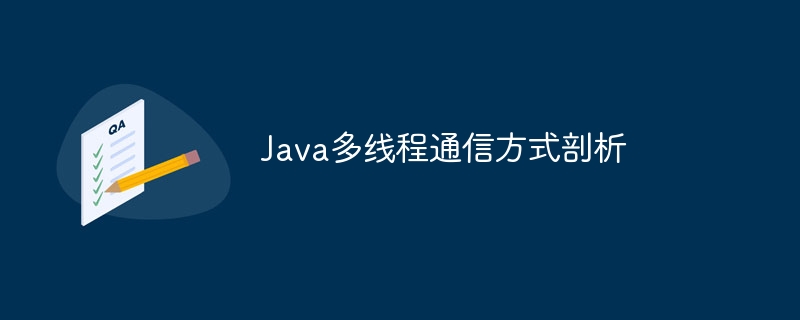在 Java 中,多執行緒通訊方式包含共享變數、wait/notify、信號量和管道。共享變數方便資料交換但容易出現並發問題;wait/notify 使用同步機制在執行緒之間等待和喚醒;信號量限制同時存取資源的執行緒數量;管道使用緩衝區實現執行緒間的資料傳遞。

Java 多執行緒通訊方式剖析
#多執行緒是並發程式設計中一個重要概念,它允許多個任務同時執行。為了在多執行緒環境中實現資料交換,我們需要了解各種通訊方式。本文將深入探討 Java 中常用的多執行緒通訊方式,包括共享變數、wait/notify、信號量和管道。
共享變數
共享變數是多個執行緒可以存取的全域變數。當一個執行緒修改共享變數時,其他執行緒可以看到變更。然而,共享變數容易出現並發問題,如競態條件和不可預測的行為。
實戰案例:
public class SharedVariableExample {
private static int sharedCounter = 0;
public static void main(String[] args) throws InterruptedException {
Thread thread1 = new Thread(() -> {
for (int i = 0; i < 1000; i++) {
sharedCounter++;
}
});
Thread thread2 = new Thread(() -> {
for (int i = 0; i < 1000; i++) {
sharedCounter--;
}
});
thread1.start();
thread2.start();
thread1.join();
thread2.join();
System.out.println("最终共享计数器:" + sharedCounter);
}
}wait/notify
wait/notify 是 Java 中內建的同步機制。 wait() 方法會使目前執行緒進入等待狀態,直到其他執行緒呼叫 notify() 或 notifyAll() 方法將其喚醒。
實戰案例:
public class WaitNotifyExample {
private static Object lock = new Object();
private static boolean dataAvailable = false;
public static void main(String[] args) throws InterruptedException {
Thread producer = new Thread(() -> {
synchronized (lock) {
while (!dataAvailable) {
try {
lock.wait();
} catch (InterruptedException e) {
e.printStackTrace();
}
}
System.out.println("处理数据...");
}
});
Thread consumer = new Thread(() -> {
synchronized (lock) {
dataAvailable = true;
lock.notify();
}
});
producer.start();
consumer.start();
producer.join();
consumer.join();
}
}信號量
信號量是一種同步機制,它允許特定數量的線程同時存取一個資源。當一個執行緒取得信號量時,信號量計數器會減少;當它釋放信號量時,計數器會增加。
實戰案例:
public class SemaphoreExample {
private static Semaphore semaphore = new Semaphore(2);
public static void main(String[] args) throws InterruptedException {
Thread thread1 = new Thread(() -> {
try {
semaphore.acquire();
System.out.println("线程 1 进入临界区");
} catch (InterruptedException e) {
e.printStackTrace();
} finally {
semaphore.release();
}
});
Thread thread2 = new Thread(() -> {
try {
semaphore.acquire();
System.out.println("线程 2 进入临界区");
} catch (InterruptedException e) {
e.printStackTrace();
} finally {
semaphore.release();
}
});
thread1.start();
thread2.start();
thread1.join();
thread2.join();
}
}管道
管道是一種用於執行緒之間通訊的特殊資料結構。它就像一個緩衝區,一個線程可以寫入數據,另一個線程可以讀取數據。
實戰案例:
public class PipeExample {
private static PipedOutputStream pos = new PipedOutputStream();
private static PipedInputStream pis = new PipedInputStream(pos);
public static void main(String[] args) throws IOException {
Thread writer = new Thread(() -> {
try {
pos.write("你好,世界!".getBytes());
} catch (IOException e) {
e.printStackTrace();
} finally {
pos.close();
}
});
Thread reader = new Thread(() -> {
try {
byte[] data = new byte[1024];
int length = pis.read(data);
System.out.println(new String(data, 0, length));
} catch (IOException e) {
e.printStackTrace();
} finally {
pis.close();
}
});
writer.start();
reader.start();
writer.join();
reader.join();
}
}以上是Java多執行緒通訊方式剖析的詳細內容。更多資訊請關注PHP中文網其他相關文章!




